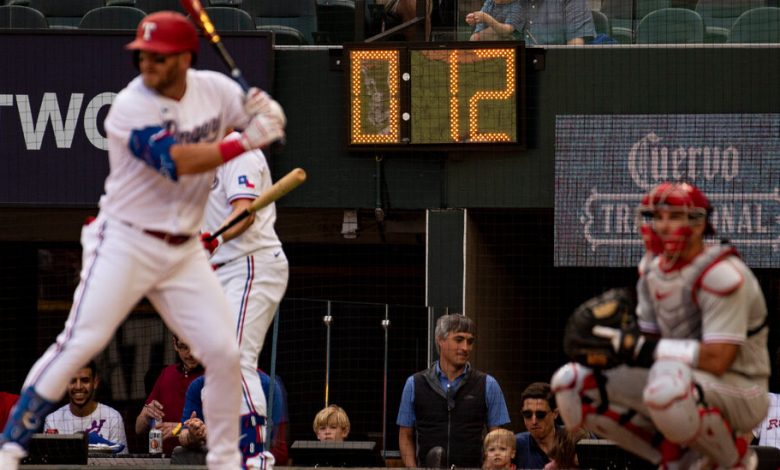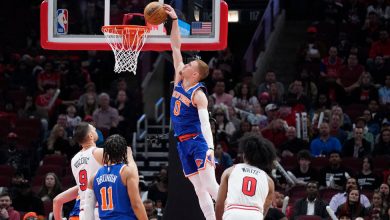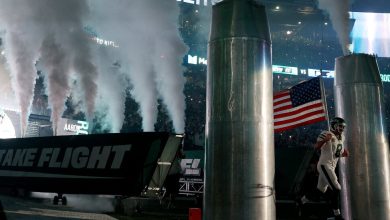With Fans Ever More Fickle, Sports Leagues Warm to Rule Changes

Texas Rangers fans are hoping the slugger Adolis Garcia can blast the franchise to its first World Series title. Arizona supporters know the Diamondbacks need to continue being greedy on the basepaths if they’re to capture a second championship. Everyone else watching has already won, thanks to a pitch clock, bigger bases and a made-over American pastime that is faster and more balletic and gets them to bed earlier.
After some early season anxiety about the economic and aesthetic impact of speeding up a Major League Baseball game, the numbers are in, showing that tinkering with the rules of what some consider a hidebound sport paid off both financially and perceptually.
The average nine-inning regular-season game was the shortest in 38 years — 2 hours 39 minutes 49 seconds, or 24 minutes less than last season and down 30 minutes from 2021. Only nine games lasted three and a half hours or longer. In 2021, that number was 390, the most in baseball history.
More than 70.7 million people attended a regular-season game, a nearly 10 percent increase over last season. That was the highest percentage of growth in 30 years, and the league recorded record revenue in merchandise and sponsorship sales. Major League Baseball estimates that the rule changes resulted in a $500 million increase in its revenue.
In an ever-evolving world where a better entertainment option is a swiped iPhone screen away, being able to respond nimbly to what a fan base wants has become critical.
The other major sports leagues — the National Basketball Association, the National Football League and the National Hockey League — have also tweaked rules recently to address questions of fan interest. And while there are always those who decry changes that affect how the games are played, the overwhelming reaction from ticket buyers and TV viewers has been positive.
“The N.B.A. and the N.F.L. have been most aggressive at actually trying to manage the game for popularity,” said John Skipper, a founder of Meadowlark Media who was an executive at ESPN from 1997 to 2017, the last five years as the company’s president.
He noted that baseball, in particular, has traditionalists who balk at wholesale changes.
“They are moving uphill against this idea that the game has to be maintained in a certain way,” he said of the league. “And I think this was a breakthrough year for baseball in which they finally confronted some of the issues.”
N.F.L. rules to protect receivers and quarterbacks, for example, may have frustrated some defensive players, but it made offenses more exciting. The N.H.L. made significant changes after a lockout canceled the 2004-5 season, including adding shootouts to decide regular-season contests.
The N.B.A. has also introduced changes to make its regular season more meaningful — adding a play-in tournament before the playoffs and, this year, a short in-season tournament. It has also made subtle changes to improve the flow of games and keep them around two hours or just a bit longer, according to Byron Spruell, the N.B.A.’s president of league operations.
The league was a bit slower to respond to concerns from fans about “load management” — the practice of star players’ not playing as much during the regular season to save their energy for the playoffs. In recent seasons, that often meant fans paid to see a superstar play, only to come away disappointed when the player sat out. The league had insisted the practice was supported by medical data, but it began this fall to shift from that narrative.
This year, with negotiations for national television rights looming, the league added provisions in the collective bargaining agreement and in new rules intended to discourage teams from resting their stars, particularly during nationally televised games. Joe Dumars, the league’s executive vice president of basketball operations, told reporters that the N.B.A. now had data proving load management doesn’t work — though an N.B.A. representative said the league could not release more specifics about that data because the reports were not final.
For baseball’s commissioner, Rob Manfred, his sport’s changes were a long time coming. He first promoted the idea of tinkering with the rules to owners after he was elected in 2015. “We had identified the patterns of play in the field that were harmful to its attractiveness,” he said.
Instead, the league moved deliberately, testing the new rules in its minor leagues while trying to get the players’ union on board.
By adopting the pitch clock, Major League Baseball has not only shortened games but has also picked up the pace of play. When the bases are empty, the pitcher has 15 seconds to start his motion. He gets 20 seconds with runners on base. That means pitchers can no longer rub the ball and stare into center field, slowing the game to a crawl.
“As soon as you sit down, it’s go time — you are focused,” said A.J. Dominguez, a fan who attended Game 3 of the American League Championship Series between the Rangers and the Houston Astros at Globe Life Field in Arlington, Texas. “The nuances between pitcher and hitter are still there, but it’s much quicker. You really feel like you are going to miss something if you look away.
“Plus, I’m getting old. I can’t be leaving here past 10 p.m.”
Sullivan Long, a beer vendor, said the faster pace kept fans in their seats and increased enthusiasm in the stands, which is good for his business. He makes $300 in tips a game now, double what he earned the previous season.
“Last year, the games sort of dragged on and I didn’t feel I was missing much action,” Long said. “Now, I am moving quicker to get to customers but keeping my eyes on the field because there is more going on.”
By enlarging the bases to 18 inches on each side from 15 inches and limiting the number of times a pitcher can try to pick off a runner, Major League Baseball is also rewarding speed and daring.
This season, Ronald Acuña Jr. of the Atlanta Braves hit 41 home runs and stole 73 bases to become baseball’s first player with a 40-70 season. In Game 7 of the National League Championship Series, the Diamondbacks stole four bases to help secure their victory over the Philadelphia Phillies. It was something they had done all year, swiping 166 bases in the regular season, the second most in the league.
Bob Costas, the broadcaster who is as steeped in baseball’s history as anyone involved with the sport, said changing the rules was a practical decision that has made the game a better viewing product without diminishing play.
“There were postseason games that lasted more than four hours,” he said. “It’s October — kids have to go school, people have to go to work. Now, they are staying with us and appreciating the game.”
Manfred said the league’s competition committee would continue to consider rule changes that it thinks will improve the on-field product. The Automatic Balls and Strikes system — colloquially known as “robot umpires” — was used to call pitches in Class AAA minor league games this past season. There are no immediate plans to incorporate it into the majors.
The evolution of Major League Baseball’s rules has paid dividends in increased attendance and attracting younger fans. The median age of ticket buyers in 2023 was 45 years old, down from 50 in 2019.
Hillary Mandel, executive vice president and head of Americas for media at the sports and entertainment conglomerate IMG, said baseball’s ability to attract younger fans will significantly affect the value of its media rights. She said she also believed that the in-person experience would enhance the television viewer’s experience.
“You know what happens when you’re watching something on television and nobody’s there,” Mandel said. “The vicarious experience for the living room fan is to live through the people who are there, whether it’s the roar of the crowd, or at a golf event seeing the throngs of people going hole to hole, screaming out when somebody’s playing.”
Still, cord cutting makes it difficult to assess the impact of the rule changes on television viewership. The regular-season television ratings of the league’s national broadcast partners — Fox, TBS and ESPN — were down slightly. The ratings for the American and National League Championships, however, averaged 5.2 million, the best in five years and up 6 percent from last year.
Major League Baseball is locked in to more than $12 billion in broadcast contracts with its national partners through 2028. The league also just concluded the second year of a seven-year, $595 million deal with Apple TV. Manfred acknowledged that between cord cutting and the upheaval in the regional cable markets, the league was still determining how to maximize its reach. But he thinks baseball is well positioned.
“We believe in the inherent value of the content,” he said. “Live sports are the single thing you can count on. At the end of the day, we think our content is valuable.”




